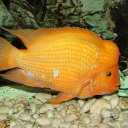The Midas cichlid, Amphilophus citrinellus, is a large cichlid fish endemic to the San Juan River and adjacent watersheds in Costa Rica and Nicaragua. A few to perhaps several dozen species are considered to exist among what has historically been called A. citrinellus, the great majority of which have not been described to date.
Considerable debate over the taxonomic status of A. citrinellus began soon after the discovery of this species in the nineteenth century. Multiple members of this speces complex have been identified and verified by genomic and mitochondrial DNA evidence in volcanic crater lakes Apoyo and Xiloá. The genetic evidence from Apoyo supports a hypothesis that the six known species of the lake evolved via sympatric speciation. The nine most recently described members of this species complex are considered endemic to their respective small, volcanic crater lakes.
Assembly
The Midas_v5 assembly was submitted by University Of Konstanz on September 2014. The assembly is on scaffold level, consisting of 67,543 contigs assembled into 6,637 scaffolds. The N50 size is the length such that 50% of the assembled genome lies in blocks of the N50 size or longer. The N50 length for the contigs is 23,456 while the scaffold N50 is 1,216,136.
Gene annotation
The gene annotation process was carried out using a combination of protein-to-genome alignments, annotation mapping from a suitable reference species and RNA-seq alignments (where RNA-seq data with appropriate meta data were publicly available). For each candidate gene region, a selection process was applied to choose the most appropriate set of transcripts based on evolutionary distance, experimental evidence for the source data and quality of the alignments. Small ncRNAs were obtained using a combination of BLAST and Infernal/RNAfold. Pseudogenes were calculated by looking at genes with a large percentage of non-biological introns (introns of <10bp), where the gene was covered in repeats, or where the gene was single exon and evidence of a functional multi-exon paralog was found elsewhere in the genome. lincRNAs were generated via RNA-seq data where no evidence of protein homology or protein domains could be found in the transcript.
In accordance with the Fort Lauderdale Agreement, please check the publication status of the genome/assembly before publishing any genome-wide analyses using these data.
More information
General information about this species can be found in Wikipedia.
Statistics
Summary
| Assembly | Midas_v5, INSDC Assembly GCA_000751415.1, Sep 2014 |
| Base Pairs | 844,902,565 |
| Golden Path Length | 844,902,565 |
| Annotation provider | Ensembl |
| Annotation method | Full genebuild |
| Genebuild started | May 2018 |
| Genebuild released | Jul 2018 |
| Genebuild last updated/patched | Jul 2018 |
| Database version | 111.5 |
Gene counts
| Coding genes | 23,696 |
| Non coding genes | 782 |
| Small non coding genes | 760 |
| Long non coding genes | 3 |
| Misc non coding genes | 19 |
| Pseudogenes | 50 |
| Gene transcripts | 32,597 |
Other
| Genscan gene predictions | 36,489 |
